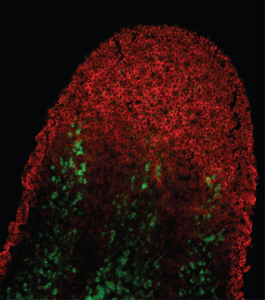
Planaria, or flatworms, are often used as a model organism to investigate the fascinating process of how tissues and organs can regenerate. The flatworm has numerous stem cells called neoblasts and, when it’s injured, this intriguing creature can actually restore its own body parts. Researchers conducted the study at the Stowers Institute for Medical Research in the lab of Alejandro Sánchez Alvarado, Ph.D., a Howard Hughes Medical Institute investigator. In two related studies, they examined stem cell differentiation and the processes that transform stem cells into skin cells, known as epidermal cells, of planaria.
The most recent study by Elizabeth Duncan and her colleagues, published in Cell Reports, is also the first published paper using chromatin immunoprecipitation (ChIP) and ChIP-sequencing (ChIP-seq) in planaria. Their study builds off of previous results found by Duncan involving chromatin, the protein-DNA complex in the cell’s nucleus. Chromatin regulation impacts the structure so that it can be more or less accessible for gene expression. Euchromatin is loosely packed and more accessible whereas heterochromatin is tightly packed and less accessible. Epigenetic tags, or post-translational modifications, are added to histone proteins by particular enzymes which affect the chromatin structure and impact chromatin remodeling. For instance, trimethylation of histone H3 lysine 4 (H3K4me3) has been well-established as a histone modification connected to active transcription.
By knocking down the levels of two enzymes responsible for H3K4me3, known as MLL1/2 and Set1, Duncan pinpointed crucial genome regions that the enzymes targeted in planarians. Set1 was linked to maintaining the stem cell population of the flatworms. When the enzyme was absent, the planaria couldn’t survive. However, when MLL1/2 was knocked down, the results were surprisingly different. The planaria did not lose their stem cells but, instead, lost the cilia on their skin and stopped swimming.
To investigate further, they collected planarian cells and analyzed the interactions between histone proteins and DNA across the whole genome with a method known as chromatin immunoprecipitation, followed by sequencing. ChIP is a powerful technique that, when combined with ChIP-seq, offers incredible insight into histone modifications and protein-DNA interactions at precise locations. Chromatin immunoprecipitation involves the binding of proteins to particular DNA sequences, allowing researchers to investigate transcription factors that interact with target genes and, in this case, histone modifications that occur at specific genomic locations. They found that the enzymes targeted genes that were associated to the cilia and the changes to these genes took place in the neoblasts.

“That was the study’s biggest surprise,” said Duncan. “I wasn’t particularly thinking in the case of MLL1/2 that the genes would be affected in the adult stem cells. I might have guessed that they would be affected in the epithelial tissue where the cilia are.”
Planarian cilia are similar human cilia, whose function is to expel mucous from the lungs. Duncan’s results indicate that disruptions of ciliogenesis, or the process of creating cilia, may start earlier than previously thought. This new information could help understand human health issues, such as primary ciliary dyskinesia, kidney and polycystic liver disease, hydrocephalus, and heart defects.
“Now we think that the stem cells may be preparing themselves to express cilia-coding genes later, and so this enzyme is needed to establish that potential,” Duncan explained.
The timing of these changes to the cells is crucial because changes in cilia-associated genes that occur in tissue cells will just affect that tissue. On the other hand, if these changes occur in neoblasts, it could affect numerous different types of tissue.
“It is important to know that MLL1/2 has the ability to set up later events, because that opens up a whole new way of thinking. For example, cilia genes have been implicated in heart defects, but it is not necessarily because cardiac cells have cilia; it’s because the change happened at some earlier stage in development,” Duncan exlained. “It seems like an important piece of the puzzle to understand that this enzyme can affect the whole group of genes that are involved in cilia. It is not just a single gene; it’s a whole collection of them.”
The study also provided powerful results because they conducted it in vivo using flatworms compared to analyzing the enzymes and the biology connected to them in a petri dish. Ultimately, they report that their results “confirm that chromatin regulation is fundamental to planarian stem cell function but also provide evidence for post-embryonic functional specificity of H3K4me3 methyltransferases in vivo.”
A subsequent study, led by Kimberly Tu, Ph.D., that was also conducted in the Sánchez Alvarado Lab, uncovered new information about the development of planarian epidermal cells, or skin cells, from neoblasts. This study also gives us clues to tissue and organ regeneration. The process entails separate steps which occur at varying times, with different genes being expressed at different stages. One gene known as egr-5, which encodes a transcription factor, was found to control the expression of these marker genes. Egr-5 was found to be highly expressed when the neoblasts began to form into epidermal cells. In addition, when egr-5 activity was reduced, the cells were unable to differentiate properly and couldn’t form mature skin cells.
Tu explained that this disruption of epidermal integrity would eventually lead to the death of the organism because the neoblasts are blocked from differentiating properly. The researchers also found that this disruption led to a stress response in the flatworm which made the neoblasts proliferate excessively and incorrectly form into neurons, gut cells, and other cells. Their findings indicate a crucial role for egr-5 in the formation of epithelial cells and planaria.
Taken together, the results from these two studies progress our understanding of histone modifications, stem cell differentiation, and tissue regeneration. With future research, scientists can apply these concepts to human models and attempt to uncover more about related diseases and potential therapies.
Sources: Duncan, E.M., Chitsazan, A.D., Seidel, C.W., Alvarado, A.S. (2015). Set1 and MLL1/2 Target Distinct Sets of Functionally Different Genomic Loci In Vivo. Cell Reports, 13(12): 2741-2755.
Tu, K.C., Cheng, L., Vu, H., Lange, J.J., McKinney, S.A., Seidel, C.W., Alvarado, A.S., (2015). Egr-5 is a post-mitotic regulator of planarian epidermal differentiation. eLife.
Reference: Stowers Institute for Medical Research. The worm has turned: New research uncovers processes driving planarian stem cell differentiation in living tissues. 17 Dec 2015.


